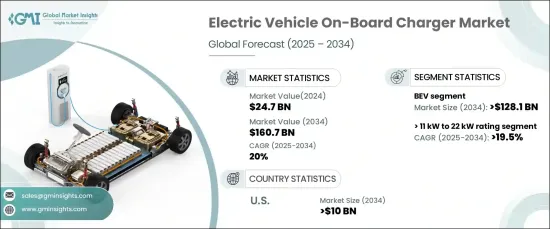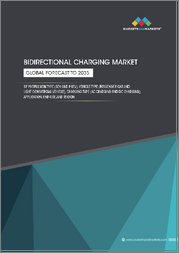
|
시장보고서
상품코드
1666636
전기자동차 온보드 충전기(OBC) 시장 : 기회, 성장 촉진요인, 산업 동향 분석 및 예측(2025-2034년)Electric Vehicle On-Board Charger Market Opportunity, Growth Drivers, Industry Trend Analysis, and Forecast 2025 - 2034 |
||||||
세계의 전기자동차 온보드 충전기 시장은 현저한 성장을 이루고 있으며, 2024년에는 247억 달러에 이르렀으며, 2025년부터 2034년까지의 CAGR은 20%가 될 것으로 예측되고 있습니다.
이러한 급속한 성장은 환경 문제, 청정 에너지를 장려하는 정부 정책, 기술 발전으로 인해 전 세계적으로 전기자동차 채택이 급증하고 있음을 반영합니다. 전 세계 소비자들이 친환경적인 장점과 비용 효율성을 이유로 전기자동차를 점점 더 많이 채택하면서 최첨단 충전 솔루션에 대한 수요가 크게 증가하고 있습니다. 충전 프로세스를 간소화하고 가동 중단 시간을 줄여주는 고성능 온보드 충전기의 개발은 이러한 성장을 주도하는 중추적인 요소입니다. 충전 프로토콜을 표준화하고 인프라를 개선하여 사용자의 편의성과 호환성을 높이고 전기 모빌리티로의 원활한 전환을 보장하기 위한 노력으로 업계는 더욱 강화되고 있습니다.

제조업체들은 충전 시간을 획기적으로 줄이고 전반적인 주행 경험을 향상시키도록 설계된 더 높은 전력 등급의 온보드 충전기를 혁신함으로써 증가하는 전기자동차 수요에 대응하고 있습니다. 더 빠르고 효율적인 충전 시스템에 대한 노력은 높아지는 소비자의 기대에 부응하고, 전기자동차 생태계를 발전시키는 데 있어 기술 발전의 중요성을 강조합니다.
| 시장 범위 | |
|---|---|
| 시작 연도 | 2024년 |
| 예측 연도 | 2025-2034년 |
| 시작 금액 | 247억 달러 |
| 예측 금액 | 1,607억 달러 |
| CAGR | 20% |
배터리 전기 자동차(BEV)를 위한 온보드 충전기 시장은 2034년까지 1,281억 달러에 달할 것으로 예상됩니다. 배터리에 저장된 전기 에너지로만 구동되는 BEV는 온실가스 배출을 줄이고 대기 오염을 방지하는 데 적극적으로 기여하는 무공해 솔루션입니다. 충전 기술 및 인프라의 발전과 지속 가능한 대안에 대한 소비자의 관심이 급증하면서 BEV와 온보드 충전기가 전례 없는 성장을 이룰 수 있는 길을 열어가고 있습니다. 공공 충전 네트워크의 가용성 증가와 정부 인센티브는 소비자들이 이러한 친환경 차량으로 전환하도록 장려하여 시장 모멘텀을 강화합니다.
정격 전력 11-22kW의 온보드 충전기는 2034년까지 연평균 19.5% 성장할 것으로 예상되며, 이는 더 빠르고 강력한 충전 솔루션에 대한 소비자 선호도가 뚜렷하게 변화하고 있음을 반영합니다. 시간에 민감한 사용자의 요구를 충족하도록 설계된 이러한 충전기는 더 빠르고 효율적인 에너지 보충을 보장하여 더 많은 사람들에게 전기자동차를 실용적인 선택으로 만들어 줍니다. 이에 따라 제조업체는 이러한 진화하는 요구 사항을 충족하는 더 높은 성능의 충전기를 제공하기 위해 혁신의 경계를 넓히고 있습니다.
미국의 전기자동차 온보드 충전기 시장은 전기화와 지속 가능한 운송에 대한 전국적인 강조에 힘입어 2034년까지 100억 달러 규모의 시장을 형성할 것으로 예상됩니다. 연방 및 주 차원의 인센티브, 소비자 인식, 양방향 충전 기능과 같은 기술 발전과 같은 요인이 이러한 성장의 주요 원인입니다. 배기가스 감축과 청정 교통수단 장려를 목표로 하는 정책은 전기자동차 도입을 위한 강력한 기반을 마련하고 있으며, 미국은 전기 모빌리티로의 글로벌 전환에서 중요한 역할을 담당하고 있습니다.
목차
제1장 조사 방법과 조사 범위
- 시장 범위와 정의
- 시장 추계 및 예측 파라미터
- 예측 계산
- 데이터 출처
- 1차 데이터
- 2차 데이터
- 유료
- 공적
제2장 주요 요약
제3장 업계 인사이트
- 생태계 분석
- 규제 상황
- 업계에 미치는 영향요인
- 성장 촉진요인
- 업계의 잠재적 위험 및 과제
- 성장 가능성 분석
- Porter's Five Forces 분석
- 공급기업의 협상력
- 구매자의 협상력
- 신규 참가업체의 위협
- 대체품의 위협
- PESTEL 분석
제4장 경쟁 구도
- 소개
- 전략적 전망
- 혁신과 지속가능성의 전망
제5장 시장 규모와 예측 : 추진력별(2021-2034년)
- 주요 동향
- BEV
- PHEV
- 기타
제6장 시장 규모와 예측 : 정격별(2021-2034년)
- 주요 동향
- 11kW 미만
- 11-22kW
- 22kW 이상
제7장 시장 규모와 예측 : 지역별(2021-2034년)
- 주요 동향
- 북미
- 미국
- 캐나다
- 멕시코
- 유럽
- 노르웨이
- 독일
- 프랑스
- 네덜란드
- 영국
- 스웨덴
- 아시아태평양
- 중국
- 일본
- 인도
- 한국
- 호주
- 중동 및 아프리카
- 사우디아라비아
- 아랍에미리트(UAE)
- 남아프리카
- 라틴아메리카
- 브라질
- 아르헨티나
제8장 기업 프로파일
- Bel Fuse
- BorgWarner
- Brusa Elektronik
- Delta Energy Systems
- Eaton
- Ficosa Internacional
- Hyundai Motors
- Infineon Technologies
- Innolectric
- Nissan Motor
- Phinia
- Stercom Power Solutions
- STMicroelectronics
- Tesla
- Toyota Industries
- Valeo
- Xepics Italia
The Global Electric Vehicle On-Board Charger Market is experiencing remarkable growth, reaching USD 24.7 billion in 2024, with projections indicating a CAGR of 20% between 2025 and 2034. This rapid expansion reflects a global surge in EV adoption, driven by environmental concerns, government policies promoting clean energy, and technological advancements. Consumers worldwide are increasingly embracing EVs for their eco-friendly benefits and cost efficiency, creating significant demand for cutting-edge charging solutions. The development of high-performance on-board chargers, which streamline charging processes and reduce downtime, is a pivotal factor in driving this growth. The industry is further bolstered by efforts to standardize charging protocols and enhance infrastructure, enabling greater convenience and compatibility for users, thus ensuring a seamless transition to electric mobility.

Manufacturers are responding to rising EV demand by innovating on-board chargers with higher power ratings, designed to drastically reduce charging times and enhance the overall driving experience. The commitment to faster, more efficient charging systems aligns with growing consumer expectations and underscores the importance of technological progress in advancing the EV ecosystem.
| Market Scope | |
|---|---|
| Start Year | 2024 |
| Forecast Year | 2025-2034 |
| Start Value | $24.7 Billion |
| Forecast Value | $160.7 Billion |
| CAGR | 20% |
The on-board charger market for battery electric vehicles (BEVs) is expected to reach USD 128.1 billion by 2034. BEVs, powered exclusively by electric energy stored in batteries, represent a zero-emission solution that actively contributes to reducing greenhouse gas emissions and combating air pollution. Advances in charging technologies and infrastructure, alongside a surge in consumer interest in sustainable alternatives, are paving the way for BEVs and their on-board chargers to achieve unprecedented growth. The increasing availability of public charging networks and government incentives further incentivize consumers to transition to these eco-friendly vehicles, strengthening market momentum.
On-board chargers in the 11 kW to 22 kW power rating category are forecasted to grow at a CAGR of 19.5% through 2034, reflecting a clear shift in consumer preferences for faster, more powerful charging solutions. These chargers, designed to meet the demands of time-conscious users, ensure quicker and more efficient energy replenishment, making EVs a practical choice for a broader audience. In response, manufacturers are pushing the boundaries of innovation to deliver higher-powered chargers that meet these evolving needs.
The U.S. EV on-board charger market alone is poised to generate USD 10 billion by 2034, driven by a nationwide emphasis on electrification and sustainable transportation. Factors such as federal and state-level incentives, consumer awareness, and technological advancements-like bidirectional charging capabilities-are key contributors to this growth. Policies targeting emissions reduction and promoting clean transportation are laying a strong foundation for the adoption of EVs, positioning the U.S. as a critical player in the global shift toward electric mobility.
Table of Contents
Chapter 1 Methodology & Scope
- 1.1 Market scope & definitions
- 1.2 Market estimates & forecast parameters
- 1.3 Forecast calculation
- 1.4 Data sources
- 1.4.1 Primary
- 1.4.2 Secondary
- 1.4.2.1 Paid
- 1.4.2.2 Public
Chapter 2 Executive Summary
- 2.1 Industry synopsis, 2021 - 2034
Chapter 3 Industry Insights
- 3.1 Industry ecosystem analysis
- 3.2 Regulatory landscape
- 3.3 Industry impact forces
- 3.3.1 Growth drivers
- 3.3.2 Industry pitfalls & challenges
- 3.4 Growth potential analysis
- 3.5 Porter's analysis
- 3.5.1 Bargaining power of suppliers
- 3.5.2 Bargaining power of buyers
- 3.5.3 Threat of new entrants
- 3.5.4 Threat of substitutes
- 3.6 PESTEL analysis
Chapter 4 Competitive Landscape, 2024
- 4.1 Introduction
- 4.2 Strategic outlook
- 4.3 Innovation & sustainability landscape
Chapter 5 Market Size and Forecast, By Propulsion, 2021 – 2034 (Units, USD Billion)
- 5.1 Key trends
- 5.2 BEV
- 5.3 PHEV
- 5.4 Others
Chapter 6 Market Size and Forecast, By Rating, 2021 – 2034 (Units, USD Billion)
- 6.1 Key trends
- 6.2 < 11 kW
- 6.3 > 11 kW to 22 kW
- 6.4 > 22 kW
Chapter 7 Market Size and Forecast, By Region, 2021 – 2034 (Units, USD Billion)
- 7.1 Key trends
- 7.2 North America
- 7.2.1 U.S.
- 7.2.2 Canada
- 7.2.3 Mexico
- 7.3 Europe
- 7.3.1 Norway
- 7.3.2 Germany
- 7.3.3 France
- 7.3.4 Netherlands
- 7.3.5 UK
- 7.3.6 Sweden
- 7.4 Asia Pacific
- 7.4.1 China
- 7.4.2 Japan
- 7.4.3 India
- 7.4.4 South Korea
- 7.4.5 Australia
- 7.5 Middle East & Africa
- 7.5.1 Saudi Arabia
- 7.5.2 UAE
- 7.5.3 South Africa
- 7.6 Latin America
- 7.6.1 Brazil
- 7.6.2 Argentina
Chapter 8 Company Profiles
- 8.1 Bel Fuse
- 8.2 BorgWarner
- 8.3 Brusa Elektronik
- 8.4 Delta Energy Systems
- 8.5 Eaton
- 8.6 Ficosa Internacional
- 8.7 Hyundai Motor
- 8.8 Infineon Technologies
- 8.9 Innolectric
- 8.10 Nissan Motor
- 8.11 Phinia
- 8.12 Stercom Power Solutions
- 8.13 STMicroelectronics
- 8.14 Tesla
- 8.15 Toyota Industries
- 8.16 Valeo
- 8.17 Xepics Italia



















